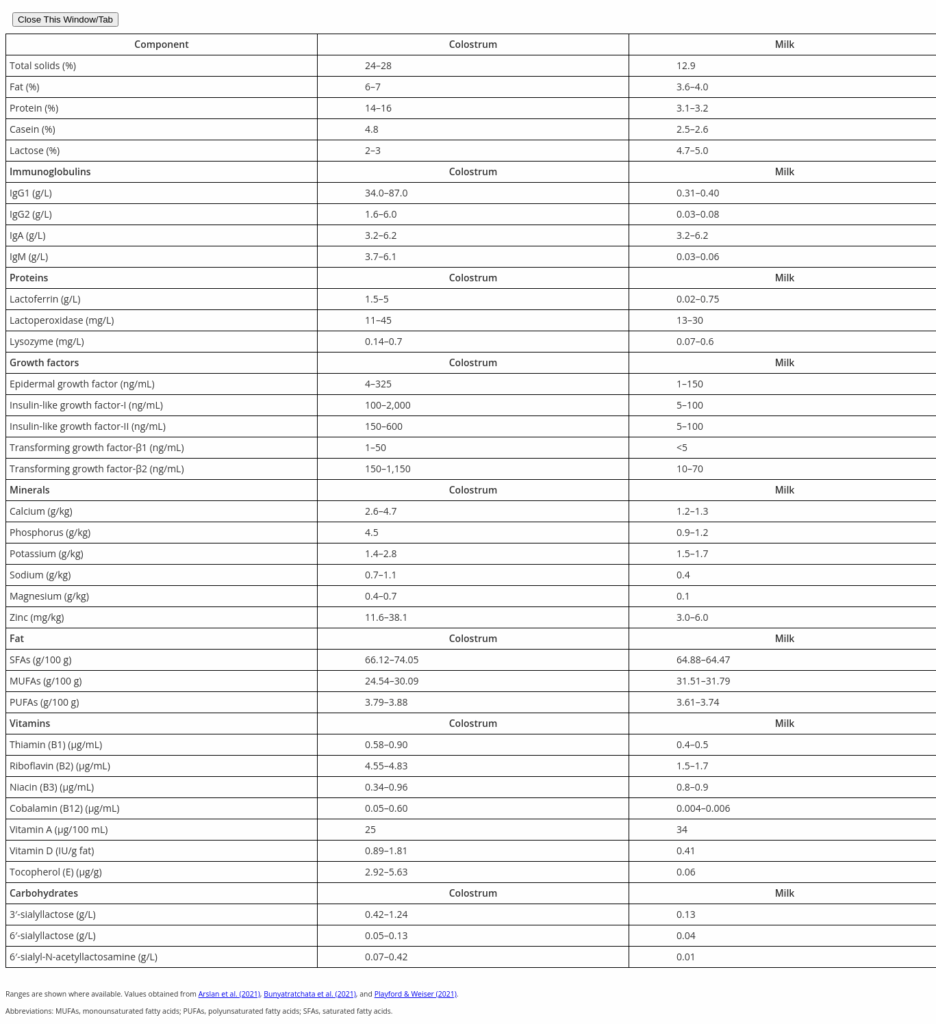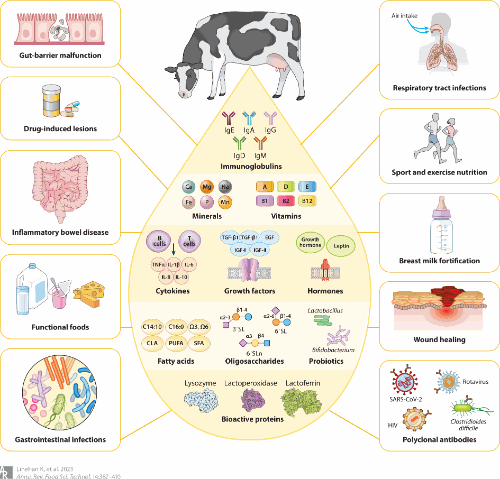Meteoric Market Rise Of Bovine Colostrum From Farm to Pharmacy
The Health Benefits and Potential of Bovine Colostrum
Bovine colostrum—the first milk produced by cows after giving birth—is packed with nutrients and biologically active substances that can support health and fight disease. Because of its rich composition, scientists and health experts are exploring ways to use it in developing functional foods, dietary supplements (also known as nutraceuticals), and even medicines for both humans and animals.
One of the reasons colostrum is gaining attention is its strong safety record. It can be used across all age groups—from newborns to the elderly—to promote general health and help manage various diseases. As global milk production has increased and new ways of processing colostrum have been developed, the market for colostrum-based products has grown rapidly. In fact, it’s expected to grow from $2.6 billion in 2019 to $4.3 billion by 2027. This is largely thanks to improved technology that can better extract and identify the helpful ingredients in colostrum.
What’s Inside Bovine Colostrum?
There are about 250 or more functional compounds found in bovine colostrum. Colostrum is richer in nutrients and bioactive substances than regular milk. It contains more protein, fat, vitamins, minerals, hormones, growth factors, and immune-supporting compounds. However, these components decrease quickly after the first few days following birth, eventually transitioning into what we know as mature milk. Unlike mature milk, colostrum has lower levels of lactose (milk sugar), which makes it easier for some people to digest.
Protein and Antibodies
Colostrum contains about 15% protein by weight, compared to just 3% in mature milk. A large portion of this protein consists of immunoglobulins (also called antibodies), which are critical for fighting infection. The most common type, IgG, makes up the majority of these antibodies. These proteins recognize harmful bacteria and viruses and help the immune system respond to them.
Antibodies are shaped like the letter Y. The top ends bind to foreign invaders, while the stem (called the Fc region) activates immune cells to attack. These cells include phagocytes, which “eat” harmful bacteria, and T cells, which help direct the immune response. Antibodies in colostrum can also help shape the gut microbiome and trigger the production of IgA, a special antibody important in protecting mucous membranes.
Colostrum has been shown to fight off a wide range of pathogens, including rotavirus, E. coli, cholera, and even HIV.
Natural Antimicrobials
Besides antibodies, colostrum also contains other powerful proteins that fight microbes. These include:
- Lactoperoxidase, an enzyme that creates toxic substances to kill bacteria.
- Lysozyme, which breaks down bacterial cell walls, causing the bacteria to die.
- Lactoferrin, a protein that binds iron (which bacteria need to grow), reducing their ability to thrive. It also boosts immune function and supports tissue growth.
These ingredients make colostrum naturally antibacterial and beneficial for immune support. Because of these properties, some components—like lactoferrin—are even extracted and added to baby formula, cosmetics, and supplements.
Immune System Helpers: Cytokines and More
Cytokines are small proteins that help cells of the immune system communicate. Even though they are found in small amounts in colostrum, they play important roles in either activating or calming the immune response. Types of cytokines found in colostrum include interleukins (ILs), tumor necrosis factor (TNF), and interferons (IFNs).
Colostrum also contains immune cells like white blood cells (including T cells, B cells, and macrophages). These cells can directly attack harmful microbes and help trigger further immune responses.
Another compound in colostrum is colostrinin, also known as proline-rich polypeptide (PRP). It helps regulate cytokine production and protects the body from inflammation and oxidative stress. Though its structure isn’t fully understood, research has shown it can reduce allergic inflammation and help fight bacterial infections in animal models. Colostrinin has been shown to prevent allergic inflammation due to common indoor and outdoor allergens. Infected rodents with enterotoxigenic E. coli (ETEC) had reduced endotoxin levels and infected lymph nodes when treated with colostrinin.
Researchers have also discovered that colostrum contains microRNAs (miRNAs)—tiny pieces of RNA that don’t make proteins but instead help control which genes are turned on or off. These miRNAs are packaged in protective vesicles, allowing them to survive the digestive process. Once inside the body, they may help guide the development of the immune system and the intestines, especially in newborns.
A Long History and Promising Future
People have been using bovine colostrum for its healing properties for thousands of years. In ancient Indian medicine (Ayurveda), colostrum was used to treat eye infections. Today, colostrum is being studied in over 120 clinical trials around the world to test its effects on both adult and infant health. Scientists hope to better understand how it might help with conditions ranging from digestive disorders to infections and even immune system disorders.
Animal studies and clinical trials in humans have shown that colostrum can help prevent or manage a wide variety of illnesses. It’s already being marketed as a health supplement and is often more effective than many of its competitors. It’s also used in the care of animals, from livestock to household pets, to improve health and resistance to disease.
Challenges and Future Research
Even though colostrum is widely used as a supplement, more research is needed. One major hurdle is the need for better quality control. Scientists are working to develop special lab tests called bioassays to help determine how much colostrum is needed to produce a specific health effect. Researchers also want to uncover more about how colostrum works inside the body, especially the roles played by its various proteins, immune factors, and genetic materials like miRNAs.
Conclusion
Bovine colostrum is a natural substance with incredible health potential. Its rich mix of proteins, antibodies, immune factors, and other nutrients makes it a powerful tool for both human and animal health. As science continues to uncover how colostrum works and how to best use it, the future looks promising for its role in supplements, medicine, and functional foods.



Immune For Life
Forgotten factors for life and health that are shaping the future of drugs and food.
Journey to a healthier lifestyle

Immune For Life
M. Ferrari
After decades of chronic health conditions and serious gut issues like IBS and SIBO, immune deficiencies and an autoimmune condition discover how I recovered my health thanks to natural oral immune therapeutics (maf and gcmaf). Due to a premature birth and being formula fed, I was a SAM child in real life. My book is a step by step journey you won't want to miss that illustrates how to regain or maintain health for all ages.